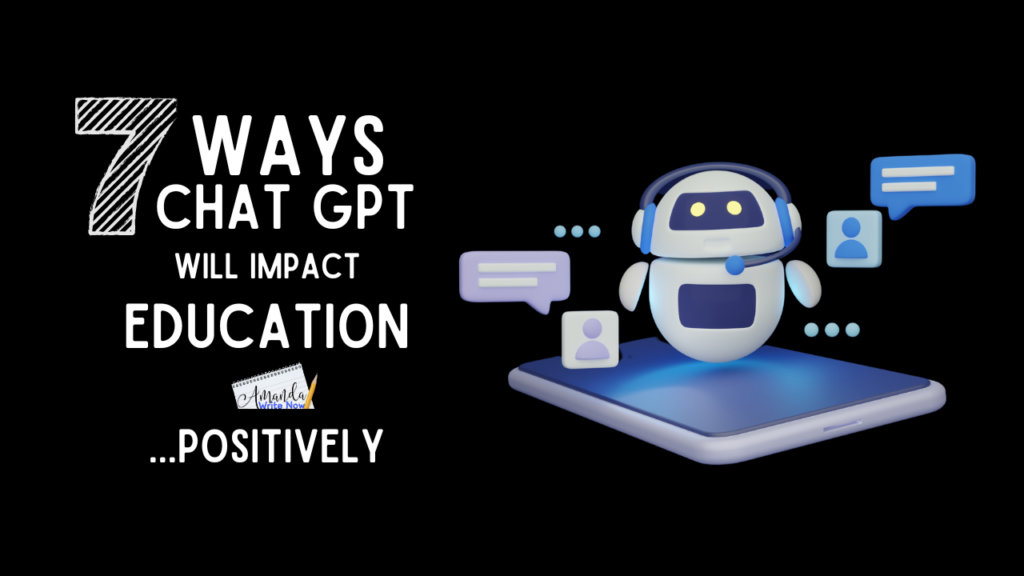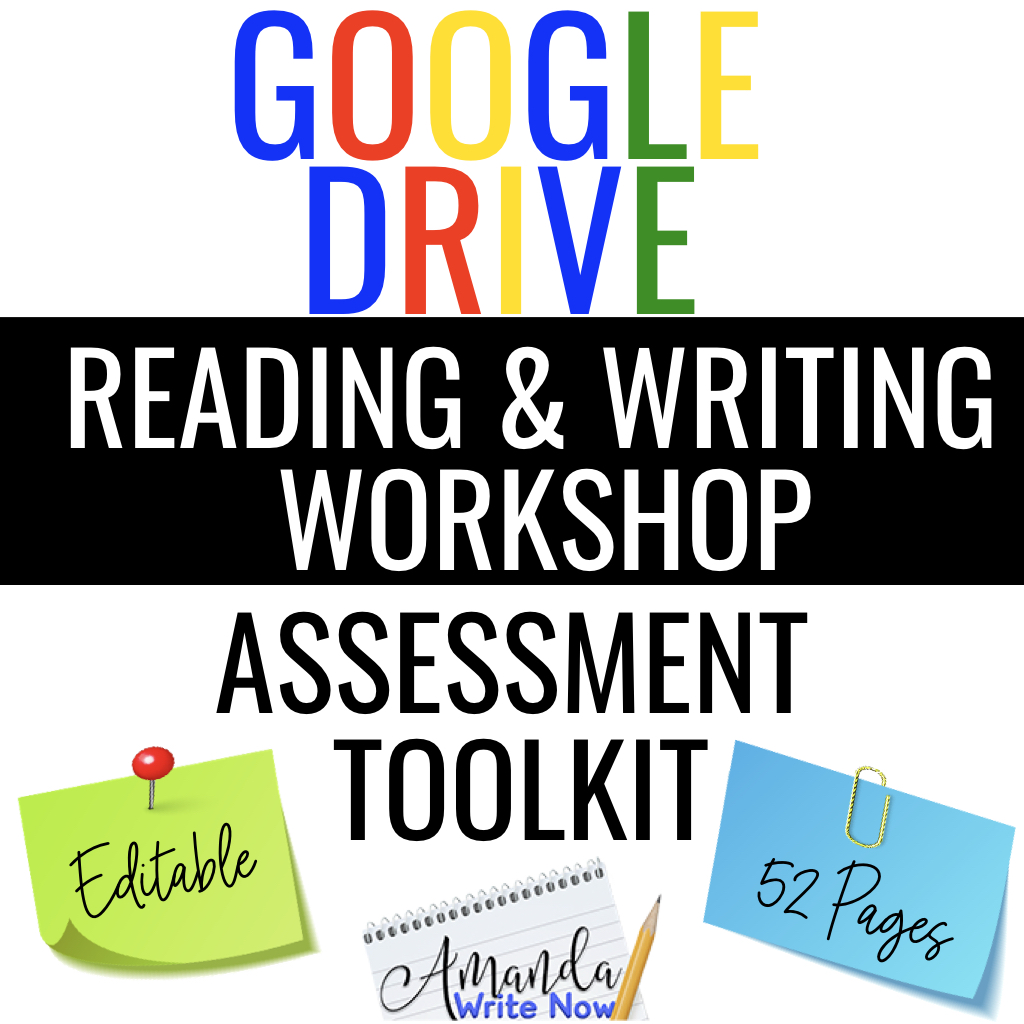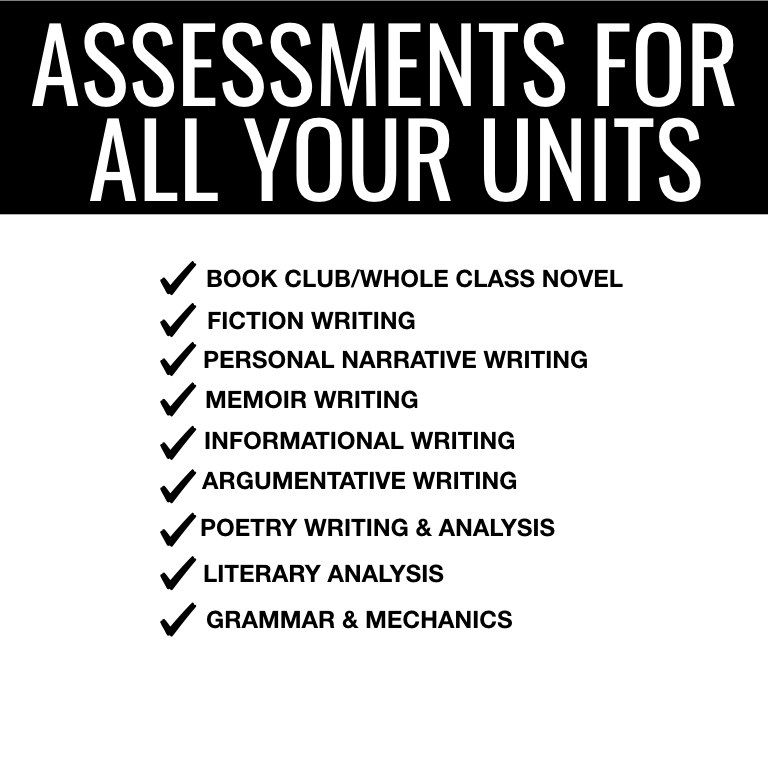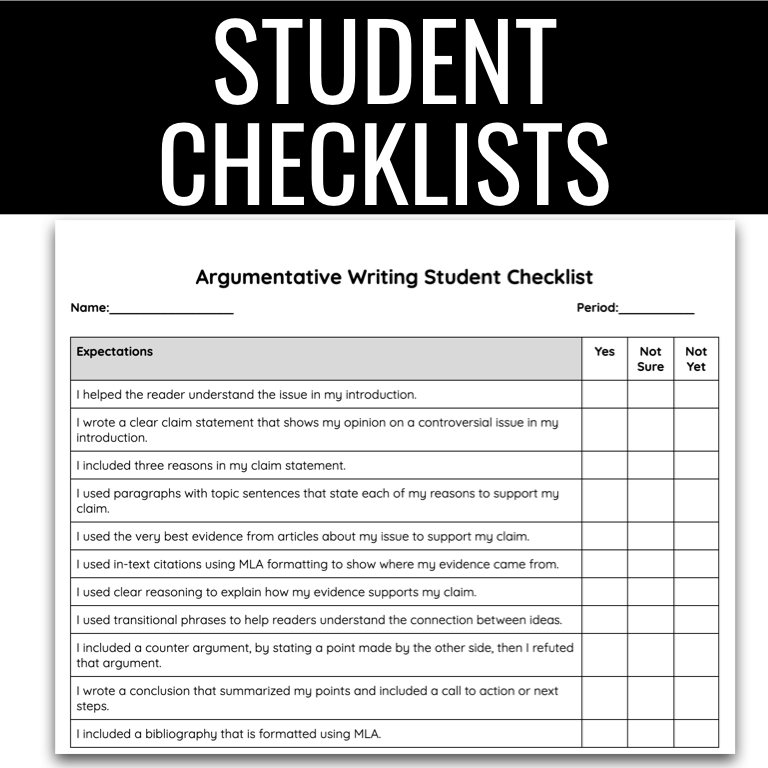
In the last few weeks I’ve been playing with, talking to teacher friends, reading articles, and thinking about one thing…
Chat GPT.
I learned about this new AI tool in early December through a Facebook Group post that had 100+comments. The comments scared me, so I decided I better check this thing out for myself. This blog post encapsulates all that I learned and my reflections about how this tool can have a positive impact on education.
So, what exactly is Chat GPT?
Chat GPT (g=generative, p=pre-trained, t=transformer) is a new artificial intelligence tool that came out November 2022. This powerful tool answers questions in a conversational style. You type your question and it types back…within seconds, no matter the question.
I asked Chat GPT to give me feedback on a personal narrative writing piece I wrote, and it did. It took about 3 seconds. Check out the response under the assessment section further down. You’ll be blown away by the amount of detailed feedback I received!
Chat GPT is among many AI tools that are part of the large language model (artificial intelligence that aggregates large amounts of words to write, spell check, auto correct, translate, and more).
Chat GPT is blowing everyones’ minds (including mine) because of its capabilities. You can ask Chat GPT to write an essay for you and then you can tell it to revise that essay by adding or deleting certain things. It can write outlines, poems, letters, advice, cover letters, resumes, and even a blog post for this website. Check out the blog posts it wrote for me to the right.
Pretty wild right? Of course I’d never publish this writing as my own without telling my audience it was written by artificial intelligence. That would be plagiarism, right?!? I believe so, and I’ll delve more into that topic in my next blog post in this series about ChatGPT.
The funniest thing I’ve seen on social media was someone asking Chat GPT to write a biblical verse in the style of the King James Bible about how to remove a sandwich out of a VCR. You can find Chat GPT’s response here. I highly recommend you try Chat GPT out for yourself, if you haven’t already, by clicking here, it’s completely free, for now.

It’s also important to know that Chat GPT is currently in beta form. There is a clear disclaimer on the website that it can produce inaccurate, blatantly incorrect information. Some have revealed it can even produce bias and racist content too, if probed in specific ways.
I believe the topic of AI tools and how they impact education is incredibly important. So important in fact that I’ve decided to dedicate the next series of blog posts on my website to helping teachers grapple with these new and fast moving technological developments.
In this blog post series I’ll discuss three essential questions teachers are asking about AI tools like Chat GPT. I’ll also attempt to answer these questions to the best of my abilities using the extensive research I’ve done about AI tools over the last couple of months. Here’s a break down of the blog posts that are to come:
Part 1: What are some of the possible impacts of AI tools like Chat GPT on teachers and students? (this post)
Part 2: How do I prevent cheating and plagiarism when tools like this exist?
Part 3: How do I talk to my students about Chat GPT?
So, let’s get started with part one, what are the possible impacts of these new technologies (tell me something good please!).
Here are the best impacts as I see them, organized by topic:
1. Teaching Writing Will Change…for the Better
Chat GPT can write virtually anything you ask of it. This tool will eventually cost money though. Even so, Chat GPT is forcing us to ponder a scary question…do students even need to learn to write anymore, if AI can do it so easily for them? I know it’s an appalling question for someone who majored in English to ask, but I believe it’s a valid one. There are many new technologies that have made past technologies irrelevant (writing is an ancient technology). Think overhead projectors, phone booths, call waiting, and Blockbuster.
So, I ask the appalling question again, will ai writing technologies really replace writing all together?
If so, then teaching writing is pointless, right?
Wrong.
Of course writing will continue to be important! We live in the information age. Copying and pasting what an ai produces into a cover letter, blog post, or essay is unethical, dishonest, and plagiarism of AI. The way we teach writing, critical thinking, and research skills needs to change. It’s needed to change for a long time. AI writing tools like Chat GPT will force this change to happen faster. But, how? English teachers are expected to teach three major genres of writing (as stated in state standards): narrative, informative, and argumentative. Chat GPT is capable of doing all of this for students, easily, quickly, and efficiently.
The purpose of school essays has needed to be put into question for a long time. Many teachers who think out of the box have pondered why they need to teach formulaic writing even before the use of ai to write was a possibility. The reason we teach formulaic writing and the five paragraph essay is because students who struggle to write need these formulas to succeed in school settings. But, students don’t necessarily need to write these genres to succeed in their future careers or in the technological age. We know this. How many jobs require employees to write personal narratives or argumentative essays?
However, to get a job students need to be able to write a cover letter. And some jobs do require a lot of technical writing in the form of reports, emails, and presentations. Students need to be able to research, think critically, and organize their ideas coherently in order to perform these tasks (more about how to teach these topics using Chat GPT in part three).
Artificial intelligence tools like Chat GPT will shift our focus in English classrooms from mastering formulas for teaching personal narrative, informative, and argumentative writing. Instead we can focus on teaching critical thinking, revision, research, discussion, and organizing ideas creatively with websites, interactive presentations, video, infographics, podcasts, blog posts, digital art, and other new and changing media forms.
We know that students who struggle with writing in elementary schools often continue to struggle with writing at every grade level. But, what if Chat GPT could change that? What if it could help? What if Chat GPT evened the playing field because it provided everyone with a clear formula for producing writing required by schools and standards? What if students were allowed to collaborate with Chat GPT? It could crank out the “formula” and students could learn to change and revise it to produce something new, unique and something they were proud of? It might even excite more students about writing! What if we harnessed this tool to benefit students rather than run away from it for fear of plagiarism and academic misconduct? More on how to prevent these issues in part two of this blog series.
If you are interested in these innovative ideas, I highly recommend you listen to act one of this episode on This American Life: The Ghost in the Machine. It’s about a writer, Vauhini Vara. She’s a journalist and fiction writer. Chat GPT allowed her to do something she never thought she could do: write about the death of her sister.
2. Learning How to Write Will Become Easier
If we put all our fears about Chat GPT aside (and there are a lot, believe me I know), teachers might consider how Chat GPT could become a writing coach or personal tutor for students.
Rather than waiting for teacher feedback, students could receive feedback within seconds with this tool. There are many potential benefits to allowing students to use Chat GPT to get feedback about their writing.
Once the feedback is provided by the AI, students can ask the AI to do specific tasks that involve revising and editing the writing. Reaping these benefits all depends on if teachers can trust students to use this tool to create something new rather than just copy and paste the responses to finish their work quickly, with little effort.
I believe we can circumnavigate students using the tool to get out of doing work by talking through these things with them (more on that in part three of this series).
I also think it would be extremely beneficial for students to complete an on demand writing assignment before starting a writing unit and using Chat GPT to get feedback.
On demand writing involves having students go through the entire writing process and finish a piece of writing in one class period without any help from the teacher (or AI tools).
The purpose? To get to know your students’ writing skills.
Check out the assessment resource below that includes on demand writing activities for every genre of writing. It also includes on demand assessments for reading units!
Maybe you are wondering, should I have students handwrite this on-demand writing?
I allow students to type on demand writing pieces because typing is faster than handwriting, and I only give students about an hour to produce their piece.
An hour is not much time, so typing is best. But, what stops a student from sneakily getting on an AI tool like Chat GPT during the on demand assessment?
If I were in the classroom, to prevent students from jumping on Chat GPT to do writing for them, I’d have students do the writing using the quiz function of Google forms.
Google form quizzes restrict students to only one tab while writing and they wouldn’t be able to open other pages or tools like Chat GPT. This would also allow students to be able to type, which is usually faster than handwriting.
Even though Chat GPT may cost money someday, I believe teachers and administrators should seriously consider utilizing this ai tool as a writing coach that provides immediate feedback to students. It could result in faster learning and more effective student writing!
3. Assessing Writing Will Change…for the Better
Teachers are so concerned in Facebook groups I’m in about Chat GPT’s ability to complete assignments for students that they may have overlooked a massive benefit of ChatGPT: it’s ability to provide a succinct summary of a piece of writing and even…grade it.
Check out what happened when I asked Chat GPT to grade my writing:
This feedback is on point! We have to ask though, is this ethical? I think if we just copied and pasted the feedback into a rubric and didn’t even read the student writing, it would be unethical. Just like it would be unethical if a student just copied and pasted what Chat GPT wrote and claimed it as their own is unethical (and plagiarizing Chat GPT).
However, if a teacher were looking for a second opinion on a student’s writing, to calibrate their assessment process this tool could be incredibly beneficial. Teachers could also require students to get feedback from the ai first, and revise based on that feedback before submitting the writing, it could be very useful to both the students and teachers!


4. Revision Can Finally Take Center Stage
If we think of Chat GPT as a teaching tool rather than the enemy, we can see that this AI tool has the potential to launch teachers and students into a whole new world when it comes to revision.
What if we started focusing our writing units on revision and editing more than any other part of the writing process?
I’ve always thought revision coming at the end of the writing process was a mistake. It should come at the beginning!
In my opinion, Chat GPT does not mean the end of high school English, as this article proclaims. Instead, we could allow students to collaborate with Chat GPT to revise writing.
How might this work?
We could start in one of two ways, with an on demand assessment (explained in the assessment section) or we could have students start chatting directly with Chat GPT from the get go.
Once students have a piece of writing in front of them (whether produced by the student during the on demand time or by Chat GPT), they can begin the revision process, revising the writing as they collaborate with Chat GPT.
I do think it would be prudent for the whole class to experiment with this process together before having students try it on their own.
Might Chat GPT allow all students to start off at the same level and from there become experts in revision and editing? Pondering this question is very exciting and I continue the evaluation of this potential in parts two and three of this series, so make sure to check those out soon.
5. Homework Will Require Rethinking
I know teachers are concerned that Chat GPT is a threat to homework and that they won’t be able to assign homework anymore because of the availability of this tool.
Educators need to realize that homework assignments are an equity and social justice issue.
In my opinion all school work should be done at school. I have many reasons for this, but mainly because there are students in every classroom who lack the time, resources, and proper home environment to be able to complete their homework successfully.
If you don’t want Chat GPT doing your students’ homework, then don’t assign homework. It’s one more reason to add to my long list of reasons why homework needs to go.
6. Critical Thinking Skills Will Become Even More Important
I believe that Chat GPT can take the teaching of critical thinking to a whole new level. This is quite contrary to what many have been saying about how the advent of Chat GPT will result in non thinking, lazy students. This won’t happen if we harness Chat GPT as a tool for the teaching of critical thinking.
Before I go further with this, what is critical thinking?
It’s research, it’s reading, it’s being able to differentiate between fact and opinion, it’s being open to multiple viewpoints, it’s being able to organize all the information you learn into something cohesive and understandable.
So, how do English teachers teach all this through writing?
The answer is, they don’t.
Teaching English is not just about writing, it’s about reading widely, it’s about discussing, and participating in healthy debates, it’s about listening.
The truth is, writing helps some students organize the information they learn, but there are other ways to organize ideas besides writing. We can also organize ideas by speaking, drawing, creating art, and music too.
Teachers might even consider having Chat GPT enter discussions about open-ended analytic questions, philosophical questions, or fake news. All of this requires human interaction and the guidance of human teachers.
Overall though, Chat GPT does not mean the end of critical thinking. Instead, it could be a tool used to enhance and improve our students’ thinking abilities, rather than stunt them.
7. Research Will Become Easier…Eventually.
Chat GPT has a very clear disclaimer warning users of inaccurate information. But, this technology is only going to get better with time.
Eventually students will be able to use AI tools to learn new information. But, if this is going to happen, teachers are going to need tools and resources for helping students identify and navigate potential wrong answers, fake news, and bias.
Honestly, these resources were needed a decade ago. Teachers are still trying to help students navigate the wild west of the world wide web, with very few tools and resources to help them do so. Part three of this blog series will help.
Young people today are incredibly tech savvy and overloaded with information. Chat GPT has the potential to streamline the research and learning process. Google search has come a long way in just a decade when it comes to providing fairly reliable information and even direct answers on the first page of search.
I think once Chat GPT has the kinks worked out, it could be an awesome research tool eventually, but as of right now, teachers need to be careful and talk to their students about misinformation being perpetuated by AI tools like Chat GPT, more on that in part three!
Wrap Up
I know that the latest technology can bring up a lot of fear for educators, rightfully so. But, if we look at the big picture, we can see the primary problem we face is not plagiarism or lazy students who don’t want to think or work, but rather, fear of the unknown.
This is exactly why I’m writing this three part series, to grapple with the unknown, to play with it…by writing.
I love writing. Writing is a vital form of communication and communication will always be an essential component of human connection. It’s a way to wrestle with things we are scared of, things that stress us out, things that we want to understand.
Communication is here to stay, it may change forms, it may evolve but human connection through communication won’t ever go away, no matter how smart AI gets.







Hi, Amanda. Missing you!
Thank you so much for your blog posts on this topic. AI is here, so we may as well harness it to our students’ advantage.
Go for it!
All best,
Susan G.
Susan, it’s great to hear from you! Let’s reconnect soon! I’d love to chat. Thanks for taking the time to comment on this blog post. How to handle the advent of Chat GPT is super overwhelming controversial. I’m seeing a lot of fear and I totally understand, I’m scared too! I just had to add my voice and ideas to the conversation:)
We have created a tool for teachers to generate student reports using the OpenAI API. Have a look at https://Teachers.Report and try the demo!
Awesome! I’ll check it out. Thanks.
Hi Amanda,
I have been reading a few of your posts and find your blogs easy to understand and informative. I particularly like this one (probably because it’s the flavor of the month) and especially the point about homework. I teach in Vietnam and the students here have enough to do already, so I tend not to give homework. Quite often the children are up to 1 o’clock in the morning finishing homework and they start school at 7.30 am in the morning. These are children of 12, 13 years, and sometimes younger.
I am an ESL teacher and run my own school which has about 300 students and 8 full-time teachers plus my wife and me. To cut to the chase, I also have my own website, http://www.vietnamesl.com, and would love to link to some of your posts. Please feel free to wander around my website. I write mainly because I enjoy it and it /, hopefully, provides some information to those who wish to come and teach in Vietnam. I have now been here for over 15 years and like to think I know a bit about Vietnam and its beautiful people. Anyway if this is ok with you, please let me know.
Hi Stephen! It’s so nice to “meet” you:) I took a look around your website and it’s awesome, and I’m sure really helpful to teachers considering teaching overseas in Vietnam, how cool! I can’t believe how hard some children are forced to work, that’s so tough. I used to work at a very high achieving school and even though I never assigned homework, I always had exhausted students confess to me how late they stayed up to finish work from other classes. This culture of workaholism to succeed is seriously unhealthy, and there are so many studies proving it! I’m glad to know there are other teachers, around the world no less, who agree and are taking necessary measures to lay off their students and assign less. Please feel free to link to anything you’d like. If I come up with a blog post that relates to teaching overseas I’ll be sure to share a link to your site too:)